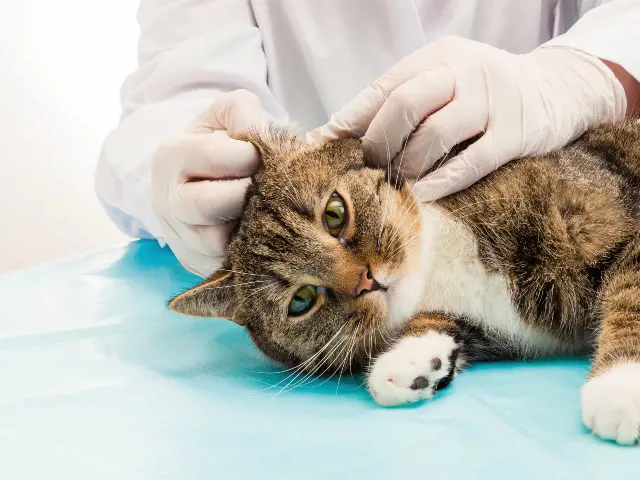Ear mites in cats and dogs
2nd April, 2024

Are you tired of seeing your furry friend constantly scratching their ears? Do they seem uncomfortable and irritable? Well, fret not, because ear mites may be the culprit!
These tiny, pesky parasites can infest the ears of both cats and dogs, causing discomfort and distress. Ear mites are like uninvited guests, sneaking into your pet's ears and causing itchiness, irritation, and even infections. But fear not, there are ways to identify and treat these unwanted visitors.
In this guide, we will explore the causes, symptoms, and treatment options for ear mites, as well as tips on prevention. So, let's dive in and help your furry companion find relief from those bothersome ear mites!
Key takeaways
- Ear mites can be transmitted through close contact with an infested animal, sharing bedding or grooming tools, or exposure to contaminated objects or environments.
- Common symptoms of ear mites in cats and dogs include excessive scratching, head shaking, rubbing ears against furniture or the floor, discomfort indicated by head tilting or holding the head to one side, and foul odour with dark, waxy discharge from the ears.
- Diagnosing ear mites involves a thorough examination of the ears using an otoscope, looking for the presence of ear mites, taking a sample of debris for further analysis, and checking for signs of redness, swelling, and discharge.
- Treating ear mites typically involves the use of medications like topical creams or drops, following the veterinarian's instructions, completing the full course of treatment, and consulting with a veterinarian for appropriate home remedies or a combination of medication and home remedies.
Causes of ear mites
If your cat or dog is suffering from ear mites, there are several common causes that may have led to their infestation. Understanding the risk factors and transmission methods associated with ear mites can help you take appropriate measures to prevent and treat this condition.
One of the main risk factors for ear mites is close contact with an infested animal. Ear mites are highly contagious and can easily spread from one pet to another through direct contact.
This can happen during social interactions or while sharing bedding, toys, or grooming tools. Additionally, outdoor pets are at a higher risk of contracting ear mites due to their exposure to other infested animals and environments.
Another common transmission method is through contaminated objects or environments. Ear mites can survive for a short period of time outside the host cat's ear canal, allowing them to be transmitted through shared items such as brushes, blankets, or furniture.
They can also be present in the environment, such as in grass, soil, or carpeting, and can infest your pet when they come into contact with these surfaces.
Symptoms and signs
You may often notice several symptoms and signs if your cat or dog is suffering from ear mites. Early detection is crucial for effective treatment, so it's important to be aware of these indications.
Common symptoms include excessive scratching of the ears, head shaking, and rubbing the ears against furniture or the floor. Your pet may also display signs of discomfort, such as frequent head tilting or holding their head to one side. You may observe a foul odour coming from their ears or notice a dark, waxy discharge.
To help you better understand the symptoms and signs of ear mites, here is a table outlining their characteristics:
|
Symptom/sign |
Description |
|
Excessive scratching |
Frequent scratching of the ears or head |
|
Head shaking |
Vigorous shaking of the head to relieve itchiness |
|
Rubbing ears |
Rubbing ears against furniture or the floor |
|
Discomfort |
Head tilting, holding head to one side |
|
Odour and discharge |
Foul odour and dark, waxy discharge from the ears |
If you suspect your pet has ear mites, it is important to consult with a veterinarian for proper diagnosis and treatment. While there are home remedies available for cat’s ear mites, it is advisable to seek professional guidance to ensure the well-being of your furry friend.
Diagnosing ear mites
To diagnose ear mites in cats and dogs, a veterinarian will typically perform a thorough examination of the ears. This examination involves looking inside the ear canal using an otoscope, which is a specialised tool designed for this purpose.
The veterinarian will be looking for the presence of ear mites, which are tiny parasites that can be seen with the help of the otoscope. The veterinarian may take a sample of the debris from the cat's ear for further analysis under a microscope. This allows for a definitive diagnosis of ear mite infestation.
During the examination, the veterinarian will also be checking for other signs of ear mite infestation, such as redness, swelling, and discharge. These symptoms can indicate a secondary infection caused by the mites.
If a diagnosis of ear mites is confirmed, the veterinarian will discuss treatment options with you. Treatment generally involves using medicated ear drops or ointments that are specifically formulated to kill the mites and relieve the symptoms.
It is important to follow the veterinarian's instructions carefully and complete the full course of treatment to ensure that the infestation is completely eradicated.
Treating ear mites
When it comes to treating ear mites in cats and dogs, there are several effective options available. Ear mite treatment medications, such as topical creams or drops, are commonly prescribed by veterinarians.
These medications contain active ingredients that target and kill the mites, helping to alleviate the symptoms and eradicate the infestation. It is important to follow the instructions provided by the veterinarian and complete the full course of treatment to ensure successful eradication of the mites.
In addition to medications, there are also some home remedies for ear mites that can be used. However, it is important to note that while these remedies may provide temporary relief, they may not completely eliminate the mites.
Some home remedies to prevent ear mites include cleaning the ears with a mixture of warm water and vinegar, using mineral oil to suffocate the mites, or applying a mixture of neem oil and almond oil to the affected area.
It is important to consult with a veterinarian before attempting any home remedies to ensure they are safe and appropriate for your pet. In some cases, a combination of medication and home remedies may be recommended for more effective treatment.
Remember to always follow the advice and guidance of your veterinarian to ensure the best outcome for your pet.
Preventing ear mites
Proper hygiene is key in preventing ear infections and mites in cats and dogs. By implementing these ear mite prevention methods, you can help keep your furry friends free from these pesky parasites.
Here are some natural remedies for ear mites that you can try:
- Regular cleaning: Clean your pet's ears regularly to remove any wax or debris that may attract ear mites. Use a gentle ear wax and cleaner recommended by your veterinarian and follow the instructions carefully.
- Avoidance of infected animals: Ear mites are highly contagious, so it's important to keep your pet away from animals that are known to have ear mites. This includes stray cats and dogs or any other pets, that show signs of ear mite infestation.
- Environmental cleanliness: Ear mites can survive in the environment, so it's crucial to keep your pet's living space clean. Regularly vacuum your home, wash their bedding on a hot cycle, and disinfect any surfaces that your pet frequently comes into contact with.
Remember that prevention is always better than cure. By following these ear mite prevention methods and using natural remedies for ear mites, you can minimise the risk of your beloved pets developing a serious ear mite infection or infestation.
If you suspect your pet may have ear mites, consult your veterinarian for a proper diagnosis and treatment plan.
Can humans get ear mites from their pets?
You're probably wondering if you can catch those pesky ear mites from your furry companions. Well, the good news is that humans can't get ear mites from their pets. So, no need to worry!
Are ear mites contagious to other animals in the household?
Ear mites can be contagious to other animals in your household. To prevent transmission, ensure all pets are treated for ear mites and regularly clean their bedding. Effective treatments for dogs ear mites include topical medications and ear drops prescribed by a veterinarian.
How long does it take to treat ear mites in cats and dogs?
Treating ear mites in cats and dogs takes time and patience. The timeline for cat ear mites varies depending on the chosen treatment option.
Different methods, such as medications or natural remedies, can be effective in eliminating these pesky critters.
Can ear mites cause permanent damage to a pet's ears?
Ear mites can indeed cause permanent damage to your pet's ears if left untreated. It's crucial to seek treatment promptly to prevent further complications and ensure a successful recovery. The duration of treatment may vary depending on the severity of the ear discharge or infestation.
Conclusion

In conclusion, ear mites are a common problem in cats and dogs that can cause discomfort and irritation. By recognising the symptoms and seeking proper diagnosis and treatment, pet owners can effectively address this issue.
It is important to note that insurance doesn’t cover preventative measures and although insurance does not cover preventative measures, prevention is always better than the cure.
To get a pet insurance quote for your furry friend you can get a quote through our website. If you would like to talk to one of our cat insurance team, you can get in touch with us on 0330 102 5748.
Helpful Pages
Recent Posts

Why do Pugs lick the air?
02/10/24Pet Insurance Quote
- 98% claims paid *
- Claims paid directly to vets
- 24/7 vet video consultations
- Interest free monthly payments



